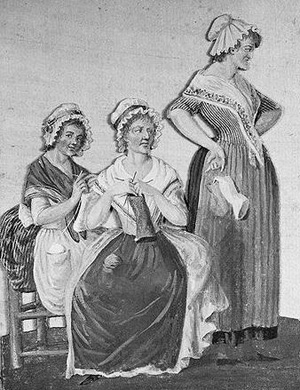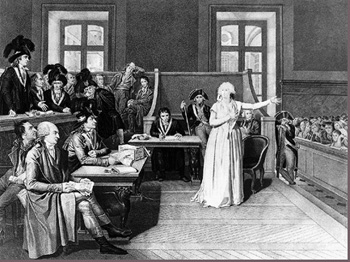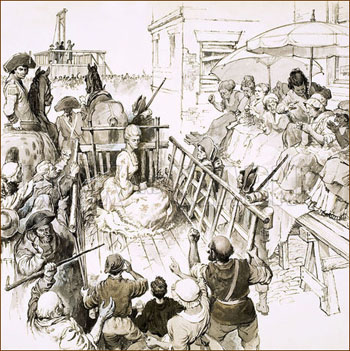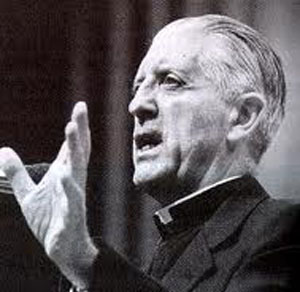Consequences of Vatican II
 |
 |
 |
 |
 |
 |
 |
Worse than the Tricoteuses…
The French word tricot is a type of knitting. The verb tricoter translates “to knit.” As a noun the term tricoteuse refers to “a knitting woman.” During the “trials” of the Reign of Terror, which began in 1793 as a consequence of the 1789 French Revolution, the tricoteuses sat in the Place de la Revolution egregiously taking pleasure in the decapitations of the guillotine, knitting in between each execution, and voicing praise after each head fell.
 An excellent rendition of this macabre scenario is shown in the 1935 movie The Scarlet Pimpernel, one of the few films that I know to be critical of the French Revolution. In actual fact, however, a curious thing happened that momentarily triumphed over the base pleasure of the tricoteuses, an event involving the editor of the extreme leftist and revolutionary newspaper Le Père Duchesne.
An excellent rendition of this macabre scenario is shown in the 1935 movie The Scarlet Pimpernel, one of the few films that I know to be critical of the French Revolution. In actual fact, however, a curious thing happened that momentarily triumphed over the base pleasure of the tricoteuses, an event involving the editor of the extreme leftist and revolutionary newspaper Le Père Duchesne.
Editor Jacques René Hebert was an atheist and had a seat in the revolutionary Paris Commune. During the “trial” of Queen Marie Antoinette he drafted a torpid and false deposition indicting the Queen for incest with her 7-year-old son, Louis Charles.
In André Castelot’s biography of the Queen, he recounts:
“With Hebert's deposition Marie Antoinette entered a new phase of her agony... Hebert put forward the declarations of ‘little Capet.’ He then stated coolly: ‘Finally, young Capet, whose health was worsening each day, was surprised by his jailor Simon in indecent defilements, baneful to his constitution. When the latter asked him who had taught him this criminal behavior, he replied that he owed his knowledge of his baneful habit to his mother and aunt.
“‘From the declaration that young Capet made in the presence of the Mayor of Paris and the Prosecutor of the Commune it was revealed that these two women often made him lie down between them; that there then took place acts of the most uncontrolled debauchery; that there was no doubt, from what Capet’s son said, that there had been an act of incest between mother and son.’” (1)
One may imagine the Queen's horror and suffering at hearing the ignominy contrived by the abominable Hebert and the part her son had been forced to play.
Louis Charles, referred to by the revolutionaries of the Terror as “Little Capet,” after having been taken forcibly from his mother, had undergone a brutal “reform.” His cruel and vulgar jailors had tried to indoctrinate him to hate his mother, often intoxicating the boy with alcohol. At one point, they claimed he uttered these scurrilous words about his aunt and mother, “Haven’t those damned whores been guillotined yet?”
 Now, in any matter of substance, ignominy has its limits and not be borne by a human populace. Utterly stunned by such a diabolical accusation, Queen Marie Antoinette simply did not answer. One of the jurors, however, demanded that the Queen gave an answer.
Now, in any matter of substance, ignominy has its limits and not be borne by a human populace. Utterly stunned by such a diabolical accusation, Queen Marie Antoinette simply did not answer. One of the jurors, however, demanded that the Queen gave an answer.
The Queen rose, much moved, and answered with great dignity: “If I did not reply it was because nature recoils from such an accusation against a mother.” Then, turning to the crowd she said: ”I appeal to all those mothers who may be here present!”(2)
At this sublime answer an electric shock ran through the audience, which revolted against that infamous accusation and manifested its support for the Queen with strong applause. Even those coarse tricoteuses were moved in spite of their habitual wickedness and applauded... Cries of protest were heard and the authorities at the Tribunal had to threaten the “disturbers.”
Thus, a sudden flash showed the tricoteuses that the prosecutor had conjured a vicious calumny. Unlike the Good Thief Dismas, however, they did not convert. To the contrary, days later, when the Queen passed the crowd in the “garbage cart” that led her to the scaffold, those women “wearing red bonnets and carrying pikes, called her vile names and applauded her execution.”
 The answer as to why they were appalled at the accusation of incest can only be attributed to the words of the Queen herself facing such a terrible charge, that “nature recoils from such an accusation against a mother.” In other words, natural law was still flickering in the hearts and souls of those knitting women.
The answer as to why they were appalled at the accusation of incest can only be attributed to the words of the Queen herself facing such a terrible charge, that “nature recoils from such an accusation against a mother.” In other words, natural law was still flickering in the hearts and souls of those knitting women.
The guillotine, the “heavy triangle of steel,” was awaiting that valiant Queen. It was the 16th of October, 1793. The Queen was 37-years-old, but looked like she was 60. She had written to her sister, “I die in the Catholic, Apostolic and Roman religion. ... As I am not free, they will perhaps bring me a (sworn) priest, but I protest here that I shall not say a word to him and that I shall treat him as a complete stranger.”
Actually, a priest who had sworn to the principles of the French Revolution was brought to give the last rites to the Queen, but she refused his assitance. It is known, however, that a Catholic priest from the Vendée, Abbé Cholet, celebrated Holy Mass and gave Communion to the Queen on the evening of October 12, before her death on the 16th. (3)
To the last, Jacques Hebert remained a “republican” and violent hater of the Royalty, both in person and in principle. After the Queen’s death, he crowed in his paper, “The slut was audacious and insolent to the end.” (4)
Vatican II, worse than the tricoteuses
Here it seems apropos to mention the words of Card. Leo Josef Suenens, one of the four Moderators who directed the Council. He approvingly declared that “Vatican II is the French Revolution in the Church.” (5) There is also then-Cardinal Ratzinger’s addition that “the text of Gaudium et Spes plays the role of a counter-Syllabus in that it represents an attempt to officially reconcile the Church with the world as it had become after 1789.” (6)
Natural law, which still existed in the souls of the tricoteuses, seems to have been entirely extinguished in the souls of Suenens and Ratzinger as they applaud the Revolution its Terror and all its consequences.
 Hebert’s atheist propaganda spread throughout France in his paper promoted a religious campaign to de-christianize society. More than 50,000 people were butchered by the Revolution’s tribunals, not just the clergy and aristocrats, but anyone even suspected of being favorable to the Altar and Throne.
Hebert’s atheist propaganda spread throughout France in his paper promoted a religious campaign to de-christianize society. More than 50,000 people were butchered by the Revolution’s tribunals, not just the clergy and aristocrats, but anyone even suspected of being favorable to the Altar and Throne.
How is it possible that Suenens and Ratzinger did not know this basic history? All the post-Vatican II Popes have enthusiastically supported the Masonic principles of the French Revolution – Liberty, Equality and Fraternity – promoting them as a great good for humanity and the world. The present Pope Francis is following the same revolutionary agenda with a spirit of vengeance.
Unfortunately, the Hierarchy and clergy applaud these actions of betrayal and self-destruction, making us wonder whether those sitting in the high chairs of the Vatican are worse than the tricoteuses of the French Revolution.
Let the counter-revolutionary remnant invoke Our Lady of Fatima to smash the revolution inside the Church and bring about the triumph of her Immaculate Heart.


The Jacobin tricoteuses knitting under the guillotine
Editor Jacques René Hebert was an atheist and had a seat in the revolutionary Paris Commune. During the “trial” of Queen Marie Antoinette he drafted a torpid and false deposition indicting the Queen for incest with her 7-year-old son, Louis Charles.
In André Castelot’s biography of the Queen, he recounts:
“With Hebert's deposition Marie Antoinette entered a new phase of her agony... Hebert put forward the declarations of ‘little Capet.’ He then stated coolly: ‘Finally, young Capet, whose health was worsening each day, was surprised by his jailor Simon in indecent defilements, baneful to his constitution. When the latter asked him who had taught him this criminal behavior, he replied that he owed his knowledge of his baneful habit to his mother and aunt.
“‘From the declaration that young Capet made in the presence of the Mayor of Paris and the Prosecutor of the Commune it was revealed that these two women often made him lie down between them; that there then took place acts of the most uncontrolled debauchery; that there was no doubt, from what Capet’s son said, that there had been an act of incest between mother and son.’” (1)
One may imagine the Queen's horror and suffering at hearing the ignominy contrived by the abominable Hebert and the part her son had been forced to play.
Louis Charles, referred to by the revolutionaries of the Terror as “Little Capet,” after having been taken forcibly from his mother, had undergone a brutal “reform.” His cruel and vulgar jailors had tried to indoctrinate him to hate his mother, often intoxicating the boy with alcohol. At one point, they claimed he uttered these scurrilous words about his aunt and mother, “Haven’t those damned whores been guillotined yet?”

The Queen appeals to the audience in the trial room
The Queen rose, much moved, and answered with great dignity: “If I did not reply it was because nature recoils from such an accusation against a mother.” Then, turning to the crowd she said: ”I appeal to all those mothers who may be here present!”(2)
At this sublime answer an electric shock ran through the audience, which revolted against that infamous accusation and manifested its support for the Queen with strong applause. Even those coarse tricoteuses were moved in spite of their habitual wickedness and applauded... Cries of protest were heard and the authorities at the Tribunal had to threaten the “disturbers.”
Thus, a sudden flash showed the tricoteuses that the prosecutor had conjured a vicious calumny. Unlike the Good Thief Dismas, however, they did not convert. To the contrary, days later, when the Queen passed the crowd in the “garbage cart” that led her to the scaffold, those women “wearing red bonnets and carrying pikes, called her vile names and applauded her execution.”

The same women mock the Queen on her way to execution
The guillotine, the “heavy triangle of steel,” was awaiting that valiant Queen. It was the 16th of October, 1793. The Queen was 37-years-old, but looked like she was 60. She had written to her sister, “I die in the Catholic, Apostolic and Roman religion. ... As I am not free, they will perhaps bring me a (sworn) priest, but I protest here that I shall not say a word to him and that I shall treat him as a complete stranger.”
Actually, a priest who had sworn to the principles of the French Revolution was brought to give the last rites to the Queen, but she refused his assitance. It is known, however, that a Catholic priest from the Vendée, Abbé Cholet, celebrated Holy Mass and gave Communion to the Queen on the evening of October 12, before her death on the 16th. (3)
To the last, Jacques Hebert remained a “republican” and violent hater of the Royalty, both in person and in principle. After the Queen’s death, he crowed in his paper, “The slut was audacious and insolent to the end.” (4)
Vatican II, worse than the tricoteuses
Here it seems apropos to mention the words of Card. Leo Josef Suenens, one of the four Moderators who directed the Council. He approvingly declared that “Vatican II is the French Revolution in the Church.” (5) There is also then-Cardinal Ratzinger’s addition that “the text of Gaudium et Spes plays the role of a counter-Syllabus in that it represents an attempt to officially reconcile the Church with the world as it had become after 1789.” (6)
Natural law, which still existed in the souls of the tricoteuses, seems to have been entirely extinguished in the souls of Suenens and Ratzinger as they applaud the Revolution its Terror and all its consequences.

Suenens: "Vatican II is the French Revolution in the Church"
How is it possible that Suenens and Ratzinger did not know this basic history? All the post-Vatican II Popes have enthusiastically supported the Masonic principles of the French Revolution – Liberty, Equality and Fraternity – promoting them as a great good for humanity and the world. The present Pope Francis is following the same revolutionary agenda with a spirit of vengeance.
Unfortunately, the Hierarchy and clergy applaud these actions of betrayal and self-destruction, making us wonder whether those sitting in the high chairs of the Vatican are worse than the tricoteuses of the French Revolution.
Let the counter-revolutionary remnant invoke Our Lady of Fatima to smash the revolution inside the Church and bring about the triumph of her Immaculate Heart.
- Andre Castelot, Queen of France – A Biography of Marie Antoinette, NY: Harper & Brothers, 1957, p. 379.
- Ibid., p. 380
- Ibid., p. 420
- Ibid., p. 408
- Leo Jozef Suenens, apud Paul Kramer, The Devil's Final Battle, Terryville, CT: The Missionary Assn., 2002, pp. 64
- Card. Ratzinger: Gaudium et Spes is a “counter-Syllabus”

Posted January 20, 2014
______________________
______________________



